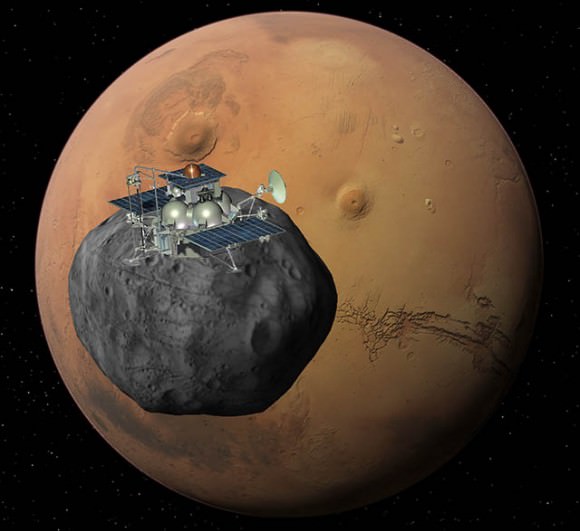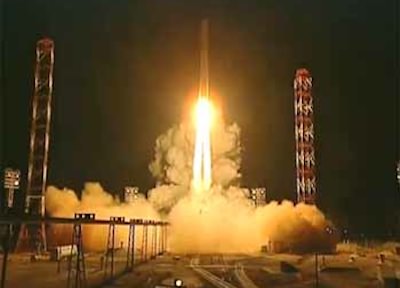Russia has successfully launched the Phobos-Grunt sample return mission to Mars aiming to return a soil sample from Phobos, the first time in history such a bold and complicated feat has been attempted.
The ambitious mission lifted off just past midnight at 00:16 Moscow time atop an upgraded version of the Zenit-2 rocket from the Baikonur Cosmodrome in Kazakhstan.
[/caption]
Phobos-Grunt is now in a parking orbit around Earth and further burns are required by the modified Fregat upper stage by 8:20 p.m. tonight to put the probe of course for Earth departure and an interplanetary cruise to the Red Planet. Watch for updates later.
The liftoff of the $163 million robotic spacecraft marks Russia’s first attempt to conduct an interplanetary mission in some 15 years since the launch failure of the Mars 96 probe back in 1996. Phobos-Grunt translates as Phobos-Soil.

The mission goal is to deploy a lander to Phobos and bring back up to 200 grams of pristine regolith and rocks from the surface of Phobos.
Also along for the ride is China’s first Mars mission named Yinghuo-1 (which means means Firefly-1) which will be jettisoned into Mars orbit as Phobos-Grunt inserts into a different orbit about Mars. Additionally, the Planetary Society’s Phobos LIFE biomodule is also on board.
The 12,000 kg Phobos-Grunt spacecraft should arrive in the vicinity of Mars around October 2012 after an 11 month interplanetary cruise. Following several months of orbital science investigations of Mars and its two moons and searching for a safe landing site, Phobos-Grunt will attempt history’s first ever touchdown on Phobos in February 2013. It will conduct a comprehensive analysis of Phobos surface and gather up to 200 grams of soil and rocks with a pair of robotic arms and a scoop device.
The samples will be transferred by a long tube onto the return vehicle mounted atop the lander. By March 2013 the ascent vehicle will take off for the trip back back to Earth.
Phobos-Grunt is equipped with a 50 kg array of 20 sophisticated science instruments including lasers, spectrometers, cameras and a microscope provided by an international team of scientists and science institutions from across Europe and Asia.
The entire voyage will last just under 3 years with the capsule plummeting through the Earth’s atmosphere in August 2014. These would represent the first macroscopic samples returned from another body in the solar system since Russia’s Luna 24 returned soil from the Moon back in 1976.


I love the fact that the average model rocket could easily reach the escape velocity of Phobos. In fact, I read that in order not to damage the lander or science instruments left on the surface, the sample return capsule will first be launched by springs to an altitude of 10 km before the rockets kick in!
Hate to be the one to break the bad news, but this mission is having SERIOUS problems right now in Earth orbit and might be game over… Stay tuned for updates… I was soooo looking forward to this mission too. Bummer….
I was soooo looking forward to this mission too. Bummer…. 